ASX Glossary - V: Difference between revisions
Jump to navigation
Jump to search
No edit summary |
No edit summary |
||
| Line 148: | Line 148: | ||
</head> | </head> | ||
<body> | <body> | ||
<table> | |||
<tr | <tr> | ||
<td class="term | <td class="term"> | ||
<a href="https://wiki.alsresume.com/index.php?title= | <a href="https://wiki.alsresume.com/index.php?title=V-speeds" target="_blank" | ||
style="color: #40E0D0; font-weight: bold; text-decoration: none; cursor: pointer;" | style="color: #40E0D0; font-weight: bold; text-decoration: none; cursor: pointer;" | ||
onmouseover="this.style.color='#ff4f01';" | onmouseover="this.style.color='#ff4f01';" | ||
onmouseout="this.style.color='#40E0D0';"> | onmouseout="this.style.color='#40E0D0';">V1 Speed</a> | ||
</td> | |||
<td class="description">V1 is the takeoff decision speed, where the pilot must either abort or commit to takeoff. If an engine fails before V1, stopping is still possible. Beyond V1, the aircraft must take off due to insufficient runway remaining to stop safely. This speed varies based on aircraft weight, runway length, and environmental conditions such as wind and temperature.</td> | |||
<td class="image-column"><img src="https://www.alsresume.com/wp-content/uploads/2025/02/V-1.jpg" alt="V1 Speed"></td> | |||
</tr> | </tr> | ||
<tr | <tr> | ||
<td class="term"> | <td class="term"> | ||
<a href="https://wiki.alsresume.com/index.php?title= | <a href="https://wiki.alsresume.com/index.php?title=V-speeds" target="_blank" | ||
style="color: #40E0D0; font-weight: bold; text-decoration: none; cursor: pointer;" | style="color: #40E0D0; font-weight: bold; text-decoration: none; cursor: pointer;" | ||
onmouseover="this.style.color='#ff4f01';" | onmouseover="this.style.color='#ff4f01';" | ||
onmouseout="this.style.color='#40E0D0';"> | onmouseout="this.style.color='#40E0D0';">V2 Speed</a> | ||
</td> | |||
<td class="description">V2 is the takeoff safety speed, providing enough climb performance to maintain altitude with one engine inoperative. It ensures a positive rate of climb while avoiding obstacles. Pilots use V2 until reaching a safe altitude, at which they accelerate further. It is calculated based on aircraft weight, engine performance, and density altitude to ensure safe departure operations.</td> | |||
<td class="image-column"><img src="https://www.alsresume.com/wp-content/uploads/2025/02/V-2.jpg" alt="V2 Speed"></td> | |||
</tr> | </tr> | ||
<tr | <tr> | ||
<td class="term"> | <td class="term"> | ||
<a href="https://wiki.alsresume.com/index.php?title= | <a href="https://wiki.alsresume.com/index.php?title=V-speeds" target="_blank" | ||
style="color: #40E0D0; font-weight: bold; text-decoration: none; cursor: pointer;" | style="color: #40E0D0; font-weight: bold; text-decoration: none; cursor: pointer;" | ||
onmouseover="this.style.color='#ff4f01';" | onmouseover="this.style.color='#ff4f01';" | ||
onmouseout="this.style.color='#40E0D0';"> | onmouseout="this.style.color='#40E0D0';">V3 Speed</a> | ||
</td> | |||
<td class="description">V3 is an additional takeoff climb speed, used in some aircraft for multi-segment climb profiles. It occurs after V2, providing increased climb efficiency while ensuring engine-out safety margins. Not all aircraft use V3, but it plays a role in aircraft certification and performance calculations for certain complex takeoff scenarios, particularly in larger commercial jets and high-performance aircraft.</td> | |||
<td class="image-column"><img src="https://www.alsresume.com/wp-content/uploads/2025/02/V-3.jpg" alt="V3 Speed"></td> | |||
</tr> | </tr> | ||
<tr | <tr> | ||
<td class="term"> | <td class="term"> | ||
<a href="https://wiki.alsresume.com/index.php?title= | <a href="https://wiki.alsresume.com/index.php?title=V-speeds" target="_blank" | ||
style="color: #40E0D0; font-weight: bold; text-decoration: none; cursor: pointer;" | style="color: #40E0D0; font-weight: bold; text-decoration: none; cursor: pointer;" | ||
onmouseover="this.style.color='#ff4f01';" | onmouseover="this.style.color='#ff4f01';" | ||
onmouseout="this.style.color='#40E0D0';"> | onmouseout="this.style.color='#40E0D0';">VA (Maneuvering Speed)</a> | ||
</td> | |||
<td class="description">VA is the maximum speed for full control deflection without causing structural damage. It provides a safety buffer for turbulence and emergency maneuvers. At speeds above VA, abrupt control inputs may overstress the airframe. VA decreases with aircraft weight, meaning lighter aircraft require lower VA values.</td> | |||
<td class="image-column"><img src="https://www.alsresume.com/wp-content/uploads/2025/03/V-speed4.jpg" alt="VA (Maneuvering Speed)"></td> | |||
</tr> | </tr> | ||
<tr | <tr> | ||
<td class="term"> | <td class="term"> | ||
<a href="https://wiki.alsresume.com/index.php?title= | <a href="https://wiki.alsresume.com/index.php?title=V-speeds" target="_blank" | ||
style="color: #40E0D0; font-weight: bold; text-decoration: none; cursor: pointer;" | style="color: #40E0D0; font-weight: bold; text-decoration: none; cursor: pointer;" | ||
onmouseover="this.style.color='#ff4f01';" | onmouseover="this.style.color='#ff4f01';" | ||
onmouseout="this.style.color='#40E0D0';"> | onmouseout="this.style.color='#40E0D0';">VAPP (Approach Speed)</a> | ||
</td> | |||
<td class="description">VAPP is the final approach speed, typically higher than the aircraft’s landing reference speed (VREF) to account for wind gusts and maneuvering. It ensures a stable approach, allowing pilots to maintain positive control before touchdown. Pilots adjust VAPP based on landing weight, wind conditions, and operational requirements to ensure a smooth, predictable descent and touchdown.</td> | |||
<td class="image-column"><img src="https://www.alsresume.com/wp-content/uploads/2025/02/VAPP.jpg" alt="VAPP (Approach Speed)"></td> | |||
</tr> | </tr> | ||
<tr | <tr> | ||
<td class="term"> | <td class="term"> | ||
<a href="https://wiki.alsresume.com/index.php?title= | <a href="https://wiki.alsresume.com/index.php?title=Variable-pitch_propeller_(aeronautics)" target="_blank" | ||
style="color: #40E0D0; font-weight: bold; text-decoration: none; cursor: pointer;" | style="color: #40E0D0; font-weight: bold; text-decoration: none; cursor: pointer;" | ||
onmouseover="this.style.color='#ff4f01';" | onmouseover="this.style.color='#ff4f01';" | ||
onmouseout="this.style.color='#40E0D0';"> | onmouseout="this.style.color='#40E0D0';">Variable Pitch Propeller</a> | ||
</td> | |||
<td class="description">A variable pitch propeller allows pilots to adjust the blade angle to optimize thrust and efficiency during different phases of flight. By changing the pitch, the propeller can maximize performance for takeoff, cruise, and landing. This system improves fuel economy, climb performance, and engine efficiency, making it essential for modern general aviation and commercial aircraft.</td> | |||
<td class="image-column"><img src="https://www.alsresume.com/wp-content/uploads/2025/03/Variable-Propellor.jpg" alt="Variable Pitch Propeller"></td> | |||
</tr> | </tr> | ||
<tr | <tr> | ||
<td class="term"> | <td class="term"> | ||
<a href="https://wiki.alsresume.com/index.php?title= | <a href="https://wiki.alsresume.com/index.php?title=V-speeds" target="_blank" | ||
style="color: #40E0D0; font-weight: bold; text-decoration: none; cursor: pointer;" | style="color: #40E0D0; font-weight: bold; text-decoration: none; cursor: pointer;" | ||
onmouseover="this.style.color='#ff4f01';" | onmouseover="this.style.color='#ff4f01';" | ||
onmouseout="this.style.color='#40E0D0';"> | onmouseout="this.style.color='#40E0D0';">VBE (Best Endurance Speed)</a> | ||
</td> | |||
<td class="description">VBE is the speed that maximizes fuel endurance, allowing an aircraft to stay airborne for the longest time with minimal fuel consumption. It is useful for holding patterns, search-and-rescue missions, and fuel conservation during extended flight durations.</td> | |||
<td class="image-column"><img src="https://www.alsresume.com/wp-content/uploads/2025/03/V-speed6.jpg" alt="VBE (Best Endurance Speed)"></td> | |||
</tr> | </tr> | ||
<tr> | <tr> | ||
<td class="term"> | <td class="term"> | ||
<a href="https://wiki.alsresume.com/index.php?title= | <a href="https://wiki.alsresume.com/index.php?title=Venturi_Effect" target="_blank" | ||
style="color: #40E0D0; font-weight: bold; text-decoration: none; cursor: pointer;" | style="color: #40E0D0; font-weight: bold; text-decoration: none; cursor: pointer;" | ||
onmouseover="this.style.color='#ff4f01';" | onmouseover="this.style.color='#ff4f01';" | ||
onmouseout="this.style.color='#40E0D0';"> | onmouseout="this.style.color='#40E0D0';">Venturi Effect</a> | ||
</td> | |||
<td class="description">The Venturi effect describes how airspeed increases and pressure decreases as air flows through a constricted section of a tube or passage. This principle is used in various aircraft systems, such as carburetors and airspeed indicators, to regulate airflow and enhance performance. It plays a crucial role in fluid dynamics and aerodynamics.</td> | |||
<td class="image-column"><img src="https://www.alsresume.com/wp-content/uploads/2025/03/Venturi.jpg" alt="Venturi Effect"></td> | |||
</tr> | </tr> | ||
<tr | <tr> | ||
<td class="term"> | <td class="term"> | ||
<a href="https://wiki.alsresume.com/index.php?title= | <a href="https://wiki.alsresume.com/index.php?title=Vertical_Navigation_(VNAV)" target="_blank" | ||
style="color: #40E0D0; font-weight: bold; text-decoration: none; cursor: pointer;" | style="color: #40E0D0; font-weight: bold; text-decoration: none; cursor: pointer;" | ||
onmouseover="this.style.color='#ff4f01';" | onmouseover="this.style.color='#ff4f01';" | ||
onmouseout="this.style.color='#40E0D0';"> | onmouseout="this.style.color='#40E0D0';">Vertical Navigation (VNAV)</a> | ||
</td> | |||
<td class="description">VNAV is an autopilot and flight management system function that calculates and manages altitude changes during a flight. It ensures smooth transitions between climb, cruise, and descent phases by following programmed altitude constraints. VNAV improves fuel efficiency, enhances precision approaches, and reduces pilot workload by automating altitude adjustments based on pre-set flight plans.</td> | |||
<td class="image-column"><img src="https://www.alsresume.com/wp-content/uploads/2025/03/Garmin.jpg" alt="Vertical Navigation (VNAV)"></td> | |||
</tr> | </tr> | ||
<tr | <tr> | ||
<td class="term"> | <td class="term"> | ||
<a href="https://wiki.alsresume.com/index.php?title= | <a href="https://wiki.alsresume.com/index.php?title=Vertical_Speed_Indicator_(VSI)" target="_blank" | ||
style="color: #40E0D0; font-weight: bold; text-decoration: none; cursor: pointer;" | style="color: #40E0D0; font-weight: bold; text-decoration: none; cursor: pointer;" | ||
onmouseover="this.style.color='#ff4f01';" | onmouseover="this.style.color='#ff4f01';" | ||
onmouseout="this.style.color='#40E0D0';"> | onmouseout="this.style.color='#40E0D0';">Vertical Speed Indicator (VSI)</a> | ||
</td> | |||
<td class="description">The VSI is an essential flight instrument that displays an aircraft’s rate of climb or descent, usually measured in feet per minute (fpm). It helps pilots maintain proper altitude adjustments, detect unintentional altitude deviations, and execute smooth descents or climbs. The VSI operates using static air pressure differences to determine vertical movement and provide real-time data.</td> | |||
<td class="image-column"><img src="https://www.alsresume.com/wp-content/uploads/2025/03/VSI.jpg" alt="Vertical Speed Indicator (VSI)"></td> | |||
</tr> | </tr> | ||
<tr | <tr> | ||
<td class="term"> | <td class="term"> | ||
<a href="https://wiki.alsresume.com/index.php?title= | <a href="https://wiki.alsresume.com/index.php?title=Vertical_Takeoff_and_Landing_(VTOL)" target="_blank" | ||
style="color: #40E0D0; font-weight: bold; text-decoration: none; cursor: pointer;" | style="color: #40E0D0; font-weight: bold; text-decoration: none; cursor: pointer;" | ||
onmouseover="this.style.color='#ff4f01';" | onmouseover="this.style.color='#ff4f01';" | ||
onmouseout="this.style.color='#40E0D0';"> | onmouseout="this.style.color='#40E0D0';">Vertical Takeoff and Landing (VTOL)</a> | ||
</td> | |||
<td class="description">VTOL aircraft can take off and land vertically, eliminating the need for runways. Examples include helicopters, tiltrotor aircraft like the V-22 Osprey, and jet-powered aircraft such as the Harrier Jump Jet. VTOL technology is widely used in military, search-and-rescue, and emerging urban air mobility sectors to enable efficient operations in confined spaces.</td> | |||
<td class="image-column"><img src="https://www.alsresume.com/wp-content/uploads/2025/03/VTOL.jpg" alt="Vertical Takeoff and Landing (VTOL)"></td> | |||
</tr> | </tr> | ||
<tr | <tr> | ||
<td class="term"> | <td class="term"> | ||
<a href="https://wiki.alsresume.com/index.php?title= | <a href="https://wiki.alsresume.com/index.php?title=V-speeds" target="_blank" | ||
style="color: #40E0D0; font-weight: bold; text-decoration: none; cursor: pointer;" | style="color: #40E0D0; font-weight: bold; text-decoration: none; cursor: pointer;" | ||
onmouseover="this.style.color='#ff4f01';" | onmouseover="this.style.color='#ff4f01';" | ||
onmouseout="this.style.color='#40E0D0';"> | onmouseout="this.style.color='#40E0D0';">VFC (Maximum Speed for Stability Failure)</a> | ||
</td> | |||
<td class="description">VFC is the highest speed before stability control failures occur, providing a margin before encountering flutter or aerodynamic instability. It is critical in high-speed aircraft where stability augmentation systems are necessary.</td> | |||
<td class="image-column"><img src="https://www.alsresume.com/wp-content/uploads/2025/03/V-speed7.jpg" alt="VFC (Maximum Speed for Stability Failure)"></td> | |||
</tr> | </tr> | ||
<tr | <tr> | ||
<td class="term"> | <td class="term"> | ||
<a href="https:// | <a href="https://wiki.alsresume.com/index.php?title=V-speeds" target="_blank" | ||
style="color: #40E0D0; font-weight: bold; text-decoration: none; cursor: pointer;" | style="color: #40E0D0; font-weight: bold; text-decoration: none; cursor: pointer;" | ||
onmouseover="this.style.color='#ff4f01';" | onmouseover="this.style.color='#ff4f01';" | ||
onmouseout="this.style.color='#40E0D0';"> | onmouseout="this.style.color='#40E0D0';">VFE (Maximum Flap Extended Speed)</td> | ||
<td class="description">VFE is the highest speed allowed with flaps extended. Flaps improve lift at lower speeds but also increase drag. Exceeding VFE can cause structural damage to the flaps or reduce aircraft control effectiveness. Each aircraft has multiple VFE limits based on different flap positions. Proper flap management is crucial for safe takeoffs, approaches, and landings.</td> | |||
<td class="image-column"><img src="https://www.alsresume.com/wp-content/uploads/2025/02/Flaps.jpg" alt="VFE (Maximum Flap Extended Speed)"></td> | |||
</tr> | </tr> | ||
<tr | <tr> | ||
<td class="term"> | <td class="term"> | ||
<a href="https://wiki.alsresume.com/index.php?title= | <a href="https://wiki.alsresume.com/index.php?title=Visual_Approach" target="_blank" | ||
style="color: #40E0D0; font-weight: bold; text-decoration: none; cursor: pointer;" | style="color: #40E0D0; font-weight: bold; text-decoration: none; cursor: pointer;" | ||
onmouseover="this.style.color='#ff4f01';" | onmouseover="this.style.color='#ff4f01';" | ||
onmouseout="this.style.color='#40E0D0';"> | onmouseout="this.style.color='#40E0D0';">Visual Approach</a> | ||
</td> | |||
<td class="description">A visual approach is a landing procedure in which the pilot navigates using external visual references instead of relying solely on instrument guidance. It is typically authorized by air traffic control (ATC) when weather conditions allow for clear visibility of the airport and runway environment. Pilots must maintain separation from other aircraft and follow ATC instructions while ensuring a stable descent.</td> | |||
<td class="image-column"><img src="https://www.alsresume.com/wp-content/uploads/2025/03/Visual-Approach.jpg" alt="Visual Approach"></td> | |||
</tr> | </tr> | ||
<tr | <tr> | ||
<td class="term"> | <td class="term"> | ||
<a href="https://wiki.alsresume.com/index.php?title= | <a href="https://wiki.alsresume.com/index.php?title=Visual_Meteorological_Conditions_(VMC)" target="_blank" | ||
style="color: #40E0D0; font-weight: bold; text-decoration: none; cursor: pointer;" | style="color: #40E0D0; font-weight: bold; text-decoration: none; cursor: pointer;" | ||
onmouseover="this.style.color='#ff4f01';" | onmouseover="this.style.color='#ff4f01';" | ||
onmouseout="this.style.color='#40E0D0';"> | onmouseout="this.style.color='#40E0D0';">Visual Meteorological Conditions (VMC)</a> | ||
</td> | |||
<td class="description">VMC refers to weather conditions that meet or exceed the minimum visibility and cloud clearance requirements necessary for visual flight. These conditions allow pilots to operate without reliance on instruments, using external references such as the horizon and landmarks. Regulations for VMC vary by airspace and country, ensuring safety by maintaining adequate separation between aircraft.</td> | |||
<td class="image-column"><img src="https://www.alsresume.com/wp-content/uploads/2025/03/VMC.jpg" alt="Visual Meteorological Conditions (VMC)"></td> | |||
</tr> | </tr> | ||
<tr | <tr> | ||
<td class="term"> | <td class="term"> | ||
<a href="https://wiki.alsresume.com/index.php?title= | <a href="https://wiki.alsresume.com/index.php?title=V-speeds" target="_blank" | ||
style="color: #40E0D0; font-weight: bold; text-decoration: none; cursor: pointer;" | style="color: #40E0D0; font-weight: bold; text-decoration: none; cursor: pointer;" | ||
onmouseover="this.style.color='#ff4f01';" | onmouseover="this.style.color='#ff4f01';" | ||
onmouseout="this.style.color='#40E0D0';"> | onmouseout="this.style.color='#40E0D0';">VLE (Maximum Landing Gear Extended Speed)</a> | ||
</td> | |||
<td class="description">VLE is the fastest speed an aircraft can safely fly with landing gear extended. While different from VLO (gear operation speed), VLE is critical for ensuring safe flight during emergency landing scenarios, where pilots may keep the gear extended beyond normal operating conditions.</td> | |||
<td class="image-column"><img src="https://www.alsresume.com/wp-content/uploads/2025/03/Retract.jpg" alt="VLE (Maximum Landing Gear Extended Speed)"></td> | |||
</tr> | </tr> | ||
<tr | <tr> | ||
<td class="term"> | <td class="term"> | ||
<a href="https://wiki.alsresume.com/index.php?title= | <a href="https://wiki.alsresume.com/index.php?title=V-speeds" target="_blank" | ||
style="color: #40E0D0; font-weight: bold; text-decoration: none; cursor: pointer;" | style="color: #40E0D0; font-weight: bold; text-decoration: none; cursor: pointer;" | ||
onmouseover="this.style.color='#ff4f01';" | onmouseover="this.style.color='#ff4f01';" | ||
onmouseout="this.style.color='#40E0D0';"> | onmouseout="this.style.color='#40E0D0';">VLO (Landing Gear Operating Speed)</a> | ||
</td> | |||
<td class="description">VLO is the maximum speed at which landing gear can be extended or retracted safely. Exceeding this speed while operating the gear could cause mechanical failure or excessive aerodynamic stress. It differs from VLE (Landing Gear Extended Speed), which is the maximum speed the aircraft can sustain with the gear already deployed.</td> | |||
<td class="image-column"><img src="https://www.alsresume.com/wp-content/uploads/2025/02/Landing-ear.jpg" alt="VLO (Landing Gear Operating Speed)"></td> | |||
</tr> | </tr> | ||
<tr | <tr> | ||
<td class="term"> | <td class="term"> | ||
<a href="https://wiki.alsresume.com/index.php?title= | <a href="https://wiki.alsresume.com/index.php?title=V-speeds" target="_blank" | ||
style="color: #40E0D0; font-weight: bold; text-decoration: none; cursor: pointer;" | style="color: #40E0D0; font-weight: bold; text-decoration: none; cursor: pointer;" | ||
onmouseover="this.style.color='#ff4f01';" | onmouseover="this.style.color='#ff4f01';" | ||
onmouseout="this.style.color='#40E0D0';"> | onmouseout="this.style.color='#40E0D0';">VMAX (Maximum Possible Speed)</a> | ||
</td> | |||
<td class="description">VMAX is the absolute fastest speed an aircraft can achieve, dictated by aerodynamic, structural, and engine power limits. Unlike VNE, which prevents dangerous speeds, VMAX is the theoretical maximum under ideal conditions.</td> | |||
<td class="image-column"><img src="https://www.alsresume.com/wp-content/uploads/2025/03/VMax.jpg" alt="VMAX (Maximum Possible Speed)"></td> | |||
</tr> | </tr> | ||
<tr | <tr> | ||
<td class="term"> | <td class="term"> | ||
<a href="https://wiki.alsresume.com/index.php?title= | <a href="https://wiki.alsresume.com/index.php?title=V-speeds" target="_blank" | ||
style="color: #40E0D0; font-weight: bold; text-decoration: none; cursor: pointer;" | style="color: #40E0D0; font-weight: bold; text-decoration: none; cursor: pointer;" | ||
onmouseover="this.style.color='#ff4f01';" | onmouseover="this.style.color='#ff4f01';" | ||
onmouseout="this.style.color='#40E0D0';"> | onmouseout="this.style.color='#40E0D0';">VMC (Minimum Control Speed)</a> | ||
</td> | |||
<td class="description">VMC is the minimum speed at which a multi-engine aircraft can maintain directional control with one engine inoperative. Below this speed, aerodynamic forces overpower the rudder’s ability to compensate for asymmetric thrust, leading to loss of control. VMC is tested during aircraft certification and is a critical parameter for pilots during engine-out scenarios.</td> | |||
<td class="image-column"><img src="https://www.alsresume.com/wp-content/uploads/2025/02/MCAS.jpg" alt="VMC (Minimum Control Speed)"></td> | |||
</tr> | </tr> | ||
<tr | <tr> | ||
<td class="term"> | <td class="term"> | ||
<a href="https://wiki.alsresume.com/index.php?title= | <a href="https://wiki.alsresume.com/index.php?title=V-speeds" target="_blank" | ||
style="color: # | style="color: #40E0D0; font-weight: bold; text-decoration: none; cursor: pointer;" | ||
onmouseover="this.style.color='#ff4f01';" | onmouseover="this.style.color='#ff4f01';" | ||
onmouseout="this.style.color='# | onmouseout="this.style.color='#40E0D0';">VMD (Minimum Drag Speed)</a> | ||
</td> | |||
<td class="description">VMD is the speed where induced drag and parasite drag are balanced, providing the best lift-to-drag ratio. Flying at VMD optimizes fuel efficiency, making it crucial for long-haul flights.</td> | |||
<td class="image-column"><img src="https://www.alsresume.com/wp-content/uploads/2025/03/V-Drag.jpg" alt="VMD (Minimum Drag Speed)"></td> | |||
</tr> | </tr> | ||
<tr | <tr> | ||
<td class="term"> | <td class="term"> | ||
<a href="https://wiki.alsresume.com/index.php?title= | <a href="https://wiki.alsresume.com/index.php?title=V-speeds" target="_blank" | ||
style="color: #40E0D0; font-weight: bold; text-decoration: none; cursor: pointer;" | style="color: #40E0D0; font-weight: bold; text-decoration: none; cursor: pointer;" | ||
onmouseover="this.style.color='#ff4f01';" | onmouseover="this.style.color='#ff4f01';" | ||
onmouseout="this.style.color='#40E0D0';"> | onmouseout="this.style.color='#40E0D0';">VMO (Maximum Operating Speed)</a> | ||
</td> | |||
<td class="description">VMO is the fastest speed an aircraft can operate under normal conditions without exceeding structural or aerodynamic limits. Exceeding VMO risks control surface flutter, increased drag, and possible structural damage. At higher altitudes, VMO transitions into MMO (Mach Maximum Operating Speed), as compressibility effects become more critical than airspeed limitations.</td> | |||
<td class="image-column"><img src="https://www.alsresume.com/wp-content/uploads/2025/02/VMO.jpg" alt="VMO (Maximum Operating Speed)"></td> | |||
</tr> | </tr> | ||
<tr | <tr> | ||
<td class="term"> | <td class="term"> | ||
<a href="https://wiki.alsresume.com/index.php?title= | <a href="https://wiki.alsresume.com/index.php?title=V-speeds" target="_blank" | ||
style="color: #40E0D0; font-weight: bold; text-decoration: none; cursor: pointer;" | style="color: #40E0D0; font-weight: bold; text-decoration: none; cursor: pointer;" | ||
onmouseover="this.style.color='#ff4f01';" | onmouseover="this.style.color='#ff4f01';" | ||
onmouseout="this.style.color='#40E0D0';"> | onmouseout="this.style.color='#40E0D0';">VNE (Never Exceed Speed)</a> | ||
</td> | |||
<td class="description">VNE is the absolute speed limit for an aircraft, beyond which structural failure may occur. Marked by a red line on the airspeed indicator, exceeding VNE can result in catastrophic damage. It factors in aerodynamic forces, material limitations, and aircraft design. Pilots are trained to avoid approaching VNE under any circumstances.</td> | |||
<td class="image-column"><img src="https://www.alsresume.com/wp-content/uploads/2025/02/VNE.jpg" alt="VNE (Never Exceed Speed)"></td> | |||
</tr> | </tr> | ||
<tr | <tr> | ||
<td class="term"> | <td class="term"> | ||
<a href="https://wiki.alsresume.com/index.php?title= | <a href="https://wiki.alsresume.com/index.php?title=VHF_omnidirectional_range" target="_blank" | ||
style="color: #40E0D0; font-weight: bold; text-decoration: none; cursor: pointer;" | style="color: #40E0D0; font-weight: bold; text-decoration: none; cursor: pointer;" | ||
onmouseover="this.style.color='#ff4f01';" | onmouseover="this.style.color='#ff4f01';" | ||
onmouseout="this.style.color='#40E0D0';"> | onmouseout="this.style.color='#40E0D0';">VOR (VHF Omnidirectional Range)</a> | ||
</td> | |||
<td class="description">VOR is a widely used ground-based radio navigation system that provides aircraft with azimuth information to determine their bearing relative to a station. It operates in the very high-frequency (VHF) range and enables pilots to navigate accurately along airways or establish approach paths. Many modern aircraft integrate VOR with other navigation systems such as GPS.</td> | |||
<td class="image-column"><img src="https://www.alsresume.com/wp-content/uploads/2025/03/VOR.jpg" alt="VOR (VHF Omnidirectional Range)"></td> | |||
</tr> | </tr> | ||
<tr> | |||
<td class="term"> | <td class="term"> | ||
<a href="https://wiki.alsresume.com/index.php?title= | <a href="https://wiki.alsresume.com/index.php?title=Vortex_Generator" target="_blank" | ||
style="color: #40E0D0; font-weight: bold; text-decoration: none; cursor: pointer;" | style="color: #40E0D0; font-weight: bold; text-decoration: none; cursor: pointer;" | ||
onmouseover="this.style.color='#ff4f01';" | onmouseover="this.style.color='#ff4f01';" | ||
onmouseout="this.style.color='#40E0D0';"> | onmouseout="this.style.color='#40E0D0';">Vortex Generator</a> | ||
</td> | |||
<td class="description">A vortex generator is a small aerodynamic device installed on an aircraft’s wings, tail, or fuselage to improve airflow and reduce aerodynamic drag. It creates controlled turbulence, which enhances the performance of control surfaces, increases lift, and delays airflow separation. Vortex generators are commonly used on high-performance aircraft to optimize stability, control, and fuel efficiency.</td> | |||
<td class="image-column"><img src="https://www.alsresume.com/wp-content/uploads/2025/03/Vortex-Gens.jpg" alt="Vortex Generator"></td> | |||
</tr> | </tr> | ||
<tr | <tr> | ||
<td class="term"> | <td class="term"> | ||
<a href="https://wiki.alsresume.com/index.php?title= | <a href="https://wiki.alsresume.com/index.php?title=V-speeds" target="_blank" | ||
style="color: #40E0D0; font-weight: bold; text-decoration: none; cursor: pointer;" | style="color: #40E0D0; font-weight: bold; text-decoration: none; cursor: pointer;" | ||
onmouseover="this.style.color='#ff4f01';" | onmouseover="this.style.color='#ff4f01';" | ||
onmouseout="this.style.color='#40E0D0';"> | onmouseout="this.style.color='#40E0D0';">VPD (Parachute Deployment Speed)</a> | ||
</td> | |||
<td class="description">VPD is the maximum airspeed at which an emergency parachute system can be safely deployed. Found in some general aviation aircraft with ballistic recovery systems (BRS), exceeding VPD may cause the parachute to fail or rip apart upon deployment.</td> | |||
<td class="image-column"><img src="https://www.alsresume.com/wp-content/uploads/2025/03/Parachute-deployment-speed.jpg" alt="VPD (Parachute Deployment Speed)"></td> | |||
</tr> | </tr> | ||
<tr | <tr> | ||
<td class="term"> | <td class="term"> | ||
<a href="https://wiki.alsresume.com/index.php?title= | <a href="https://wiki.alsresume.com/index.php?title=V-speeds" target="_blank" | ||
style="color: #40E0D0; font-weight: bold; text-decoration: none; cursor: pointer;" | style="color: #40E0D0; font-weight: bold; text-decoration: none; cursor: pointer;" | ||
onmouseover="this.style.color='#ff4f01';" | onmouseover="this.style.color='#ff4f01';" | ||
onmouseout="this.style.color='#40E0D0';"> | onmouseout="this.style.color='#40E0D0';">VR (Rotation Speed)</a> | ||
</td> | |||
<td class="description">VR is the speed at which a pilot initiates nose-up rotation during takeoff, transitioning the aircraft from ground roll to climb. It is based on aircraft weight, balance, and environmental factors. If rotation occurs too early or late, performance issues such as tail strikes or runway overruns may occur.</td> | |||
<td class="image-column"><img src="https://www.alsresume.com/wp-content/uploads/2025/03/V-speed.jpg" alt="VR (Rotation Speed)"></td> | |||
</tr> | </tr> | ||
<tr | <tr> | ||
<td class="term"> | <td class="term"> | ||
<a href="https://wiki.alsresume.com/index.php?title= | <a href="https://wiki.alsresume.com/index.php?title=V-speeds" target="_blank" | ||
style="color: #40E0D0; font-weight: bold; text-decoration: none; cursor: pointer;" | style="color: #40E0D0; font-weight: bold; text-decoration: none; cursor: pointer;" | ||
onmouseover="this.style.color='#ff4f01';" | onmouseover="this.style.color='#ff4f01';" | ||
onmouseout="this.style.color='#40E0D0';"> | onmouseout="this.style.color='#40E0D0';">VREF (Landing Reference Speed)</a> | ||
</td> | |||
<td class="description">VREF is the final approach reference speed, ensuring a stable descent and landing. It is calculated based on landing weight, wind conditions, and flap configuration. A proper VREF approach allows for a safe touchdown while maintaining control authority for a possible go-around if necessary.</td> | |||
<td class="image-column"><img src="https://www.alsresume.com/wp-content/uploads/2025/03/V-speed5.jpg" alt="VREF (Landing Reference Speed)"></td> | |||
</tr> | </tr> | ||
<tr | <tr> | ||
<td class="term"> | <td class="term"> | ||
<a href="https://wiki.alsresume.com/index.php?title= | <a href="https://wiki.alsresume.com/index.php?title=V-Tail_Configuration" target="_blank" | ||
style="color: #40E0D0; font-weight: bold; text-decoration: none; cursor: pointer;" | style="color: #40E0D0; font-weight: bold; text-decoration: none; cursor: pointer;" | ||
onmouseover="this.style.color='#ff4f01';" | onmouseover="this.style.color='#ff4f01';" | ||
onmouseout="this.style.color='#40E0D0';"> | onmouseout="this.style.color='#40E0D0';">V-Tail Configuration</a> | ||
</td> | |||
<td class="description">A V-tail configuration replaces the traditional vertical and horizontal stabilizers with two surfaces forming a V-shape. This design reduces drag and weight while improving aircraft efficiency. Common in light aircraft and unmanned aerial vehicles, V-tail configurations require specialized flight controls, as the rudder and elevator functions are combined into control surfaces called ruddervators.</td> | |||
<td class="image-column"><img src="https://www.alsresume.com/wp-content/uploads/2025/03/VTail.jpg" alt="V-Tail Configuration"></td> | |||
</tr> | </tr> | ||
<tr | <tr> | ||
<td class="term"> | <td class="term"> | ||
<a href="https://wiki.alsresume.com/index.php?title= | <a href="https://wiki.alsresume.com/index.php?title=V-speeds" target="_blank" | ||
style="color: #40E0D0; font-weight: bold; text-decoration: none; cursor: pointer;" | style="color: #40E0D0; font-weight: bold; text-decoration: none; cursor: pointer;" | ||
onmouseover="this.style.color='#ff4f01';" | onmouseover="this.style.color='#ff4f01';" | ||
onmouseout="this.style.color='#40E0D0';"> | onmouseout="this.style.color='#40E0D0';">VX (Best Angle-of-Climb Speed)</a> | ||
</td> | |||
<td class="description">VX provides the steepest climb angle relative to horizontal distance, used for clearing obstacles near the runway. While VX allows for the greatest altitude gain over distance, it sacrifices airspeed. It is essential for short-field takeoffs, where rapid altitude gain is necessary due to terrain or other obstructions.</td> | |||
<td class="image-column"><img src="https://www.alsresume.com/wp-content/uploads/2025/03/V-speed2.jpg" alt="VX (Best Angle-of-Climb Speed)"></td> | |||
</tr> | </tr> | ||
<tr | <tr> | ||
<td class="term"> | <td class="term"> | ||
<a href="https://wiki.alsresume.com/index.php?title= | <a href="https://wiki.alsresume.com/index.php?title=V-speeds" target="_blank" | ||
style="color: #40E0D0; font-weight: bold; text-decoration: none; cursor: pointer;" | style="color: #40E0D0; font-weight: bold; text-decoration: none; cursor: pointer;" | ||
onmouseover="this.style.color='#ff4f01';" | onmouseover="this.style.color='#ff4f01';" | ||
onmouseout="this.style.color='#40E0D0';"> | onmouseout="this.style.color='#40E0D0';">VY (Best Rate-of-Climb Speed)</a> | ||
</td> | |||
<td class="description">VY allows for the fastest altitude gain over time, maximizing climb performance while maintaining a safe airspeed. It is the most efficient climb speed used in normal operations and cruise climb. While VX provides the steepest climb, VY is more useful for reaching cruising altitude quickly.</td> | |||
<td class="image-column"><img src="https://www.alsresume.com/wp-content/uploads/2025/03/V-speed3.jpg" alt="VY (Best Rate-of-Climb Speed)"></td> | |||
</tr> | </tr> | ||
</table> | |||
</body> | </body> | ||
</html> | </html> | ||
Latest revision as of 19:39, 23 April 2025

| Click on term for full definition | Click here to report corrections and content addition requests |
| V1 Speed | V1 is the takeoff decision speed, where the pilot must either abort or commit to takeoff. If an engine fails before V1, stopping is still possible. Beyond V1, the aircraft must take off due to insufficient runway remaining to stop safely. This speed varies based on aircraft weight, runway length, and environmental conditions such as wind and temperature. | 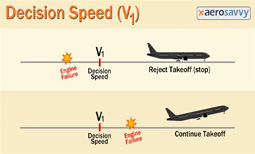 |
| V2 Speed | V2 is the takeoff safety speed, providing enough climb performance to maintain altitude with one engine inoperative. It ensures a positive rate of climb while avoiding obstacles. Pilots use V2 until reaching a safe altitude, at which they accelerate further. It is calculated based on aircraft weight, engine performance, and density altitude to ensure safe departure operations. | 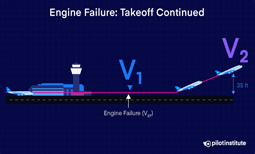 |
| V3 Speed | V3 is an additional takeoff climb speed, used in some aircraft for multi-segment climb profiles. It occurs after V2, providing increased climb efficiency while ensuring engine-out safety margins. Not all aircraft use V3, but it plays a role in aircraft certification and performance calculations for certain complex takeoff scenarios, particularly in larger commercial jets and high-performance aircraft. | 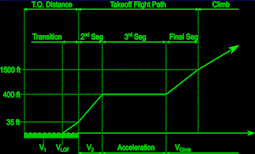 |
| VA (Maneuvering Speed) | VA is the maximum speed for full control deflection without causing structural damage. It provides a safety buffer for turbulence and emergency maneuvers. At speeds above VA, abrupt control inputs may overstress the airframe. VA decreases with aircraft weight, meaning lighter aircraft require lower VA values. |  |
| VAPP (Approach Speed) | VAPP is the final approach speed, typically higher than the aircraft’s landing reference speed (VREF) to account for wind gusts and maneuvering. It ensures a stable approach, allowing pilots to maintain positive control before touchdown. Pilots adjust VAPP based on landing weight, wind conditions, and operational requirements to ensure a smooth, predictable descent and touchdown. | 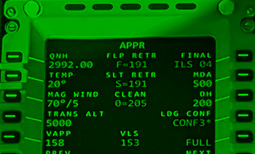 |
| Variable Pitch Propeller | A variable pitch propeller allows pilots to adjust the blade angle to optimize thrust and efficiency during different phases of flight. By changing the pitch, the propeller can maximize performance for takeoff, cruise, and landing. This system improves fuel economy, climb performance, and engine efficiency, making it essential for modern general aviation and commercial aircraft. | 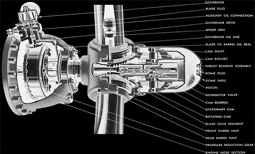 |
| VBE (Best Endurance Speed) | VBE is the speed that maximizes fuel endurance, allowing an aircraft to stay airborne for the longest time with minimal fuel consumption. It is useful for holding patterns, search-and-rescue missions, and fuel conservation during extended flight durations. | 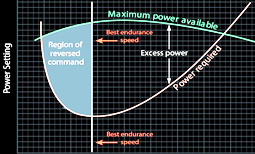 |
| Venturi Effect | The Venturi effect describes how airspeed increases and pressure decreases as air flows through a constricted section of a tube or passage. This principle is used in various aircraft systems, such as carburetors and airspeed indicators, to regulate airflow and enhance performance. It plays a crucial role in fluid dynamics and aerodynamics. | 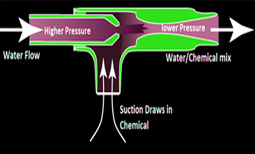 |
| Vertical Navigation (VNAV) | VNAV is an autopilot and flight management system function that calculates and manages altitude changes during a flight. It ensures smooth transitions between climb, cruise, and descent phases by following programmed altitude constraints. VNAV improves fuel efficiency, enhances precision approaches, and reduces pilot workload by automating altitude adjustments based on pre-set flight plans. | 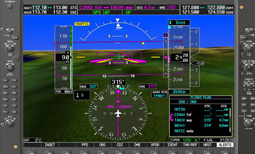 |
| Vertical Speed Indicator (VSI) | The VSI is an essential flight instrument that displays an aircraft’s rate of climb or descent, usually measured in feet per minute (fpm). It helps pilots maintain proper altitude adjustments, detect unintentional altitude deviations, and execute smooth descents or climbs. The VSI operates using static air pressure differences to determine vertical movement and provide real-time data. | 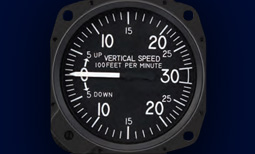 |
| Vertical Takeoff and Landing (VTOL) | VTOL aircraft can take off and land vertically, eliminating the need for runways. Examples include helicopters, tiltrotor aircraft like the V-22 Osprey, and jet-powered aircraft such as the Harrier Jump Jet. VTOL technology is widely used in military, search-and-rescue, and emerging urban air mobility sectors to enable efficient operations in confined spaces. | 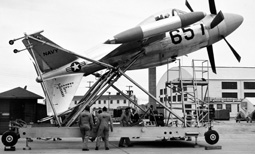 |
| VFC (Maximum Speed for Stability Failure) | VFC is the highest speed before stability control failures occur, providing a margin before encountering flutter or aerodynamic instability. It is critical in high-speed aircraft where stability augmentation systems are necessary. | 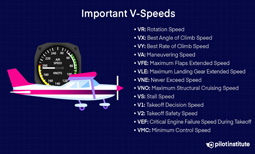 |
| VFE (Maximum Flap Extended Speed) | VFE is the highest speed allowed with flaps extended. Flaps improve lift at lower speeds but also increase drag. Exceeding VFE can cause structural damage to the flaps or reduce aircraft control effectiveness. Each aircraft has multiple VFE limits based on different flap positions. Proper flap management is crucial for safe takeoffs, approaches, and landings. |  |
| Visual Approach | A visual approach is a landing procedure in which the pilot navigates using external visual references instead of relying solely on instrument guidance. It is typically authorized by air traffic control (ATC) when weather conditions allow for clear visibility of the airport and runway environment. Pilots must maintain separation from other aircraft and follow ATC instructions while ensuring a stable descent. | 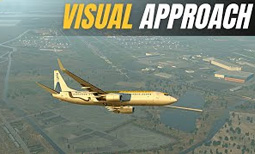 |
| Visual Meteorological Conditions (VMC) | VMC refers to weather conditions that meet or exceed the minimum visibility and cloud clearance requirements necessary for visual flight. These conditions allow pilots to operate without reliance on instruments, using external references such as the horizon and landmarks. Regulations for VMC vary by airspace and country, ensuring safety by maintaining adequate separation between aircraft. | 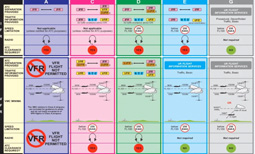 |
| VLE (Maximum Landing Gear Extended Speed) | VLE is the fastest speed an aircraft can safely fly with landing gear extended. While different from VLO (gear operation speed), VLE is critical for ensuring safe flight during emergency landing scenarios, where pilots may keep the gear extended beyond normal operating conditions. | 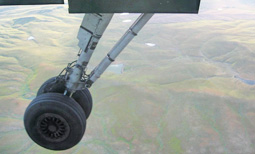 |
| VLO (Landing Gear Operating Speed) | VLO is the maximum speed at which landing gear can be extended or retracted safely. Exceeding this speed while operating the gear could cause mechanical failure or excessive aerodynamic stress. It differs from VLE (Landing Gear Extended Speed), which is the maximum speed the aircraft can sustain with the gear already deployed. | 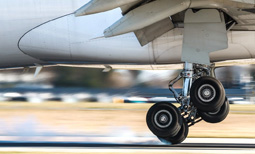 |
| VMAX (Maximum Possible Speed) | VMAX is the absolute fastest speed an aircraft can achieve, dictated by aerodynamic, structural, and engine power limits. Unlike VNE, which prevents dangerous speeds, VMAX is the theoretical maximum under ideal conditions. | 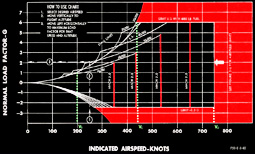 |
| VMC (Minimum Control Speed) | VMC is the minimum speed at which a multi-engine aircraft can maintain directional control with one engine inoperative. Below this speed, aerodynamic forces overpower the rudder’s ability to compensate for asymmetric thrust, leading to loss of control. VMC is tested during aircraft certification and is a critical parameter for pilots during engine-out scenarios. | 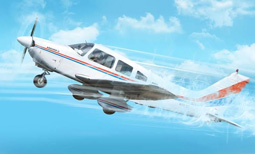 |
| VMD (Minimum Drag Speed) | VMD is the speed where induced drag and parasite drag are balanced, providing the best lift-to-drag ratio. Flying at VMD optimizes fuel efficiency, making it crucial for long-haul flights. | 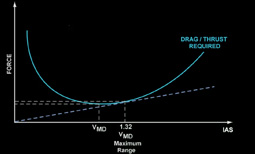 |
| VMO (Maximum Operating Speed) | VMO is the fastest speed an aircraft can operate under normal conditions without exceeding structural or aerodynamic limits. Exceeding VMO risks control surface flutter, increased drag, and possible structural damage. At higher altitudes, VMO transitions into MMO (Mach Maximum Operating Speed), as compressibility effects become more critical than airspeed limitations. |  |
| VNE (Never Exceed Speed) | VNE is the absolute speed limit for an aircraft, beyond which structural failure may occur. Marked by a red line on the airspeed indicator, exceeding VNE can result in catastrophic damage. It factors in aerodynamic forces, material limitations, and aircraft design. Pilots are trained to avoid approaching VNE under any circumstances. | 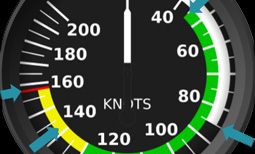 |
| VOR (VHF Omnidirectional Range) | VOR is a widely used ground-based radio navigation system that provides aircraft with azimuth information to determine their bearing relative to a station. It operates in the very high-frequency (VHF) range and enables pilots to navigate accurately along airways or establish approach paths. Many modern aircraft integrate VOR with other navigation systems such as GPS. |  |
| Vortex Generator | A vortex generator is a small aerodynamic device installed on an aircraft’s wings, tail, or fuselage to improve airflow and reduce aerodynamic drag. It creates controlled turbulence, which enhances the performance of control surfaces, increases lift, and delays airflow separation. Vortex generators are commonly used on high-performance aircraft to optimize stability, control, and fuel efficiency. | 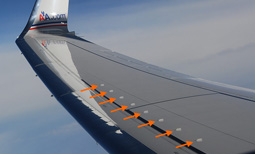 |
| VPD (Parachute Deployment Speed) | VPD is the maximum airspeed at which an emergency parachute system can be safely deployed. Found in some general aviation aircraft with ballistic recovery systems (BRS), exceeding VPD may cause the parachute to fail or rip apart upon deployment. | 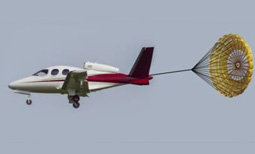 |
| VR (Rotation Speed) | VR is the speed at which a pilot initiates nose-up rotation during takeoff, transitioning the aircraft from ground roll to climb. It is based on aircraft weight, balance, and environmental factors. If rotation occurs too early or late, performance issues such as tail strikes or runway overruns may occur. | 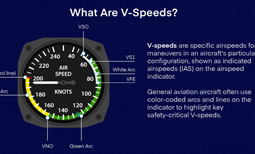 |
| VREF (Landing Reference Speed) | VREF is the final approach reference speed, ensuring a stable descent and landing. It is calculated based on landing weight, wind conditions, and flap configuration. A proper VREF approach allows for a safe touchdown while maintaining control authority for a possible go-around if necessary. | 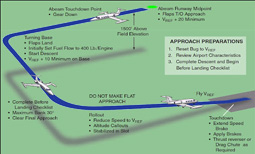 |
| V-Tail Configuration | A V-tail configuration replaces the traditional vertical and horizontal stabilizers with two surfaces forming a V-shape. This design reduces drag and weight while improving aircraft efficiency. Common in light aircraft and unmanned aerial vehicles, V-tail configurations require specialized flight controls, as the rudder and elevator functions are combined into control surfaces called ruddervators. | 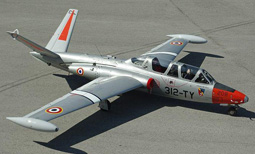 |
| VX (Best Angle-of-Climb Speed) | VX provides the steepest climb angle relative to horizontal distance, used for clearing obstacles near the runway. While VX allows for the greatest altitude gain over distance, it sacrifices airspeed. It is essential for short-field takeoffs, where rapid altitude gain is necessary due to terrain or other obstructions. |  |
| VY (Best Rate-of-Climb Speed) | VY allows for the fastest altitude gain over time, maximizing climb performance while maintaining a safe airspeed. It is the most efficient climb speed used in normal operations and cruise climb. While VX provides the steepest climb, VY is more useful for reaching cruising altitude quickly. | 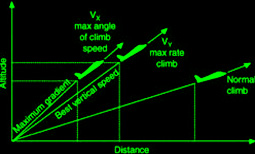 |
